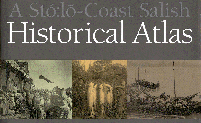
A Stó:lō – Coast Salish Historical Atlas, a #1 Best Seller (B.C. non-fiction) and winner of both the Roderick Haig-Brown Regional B.C. Book Award and Vancouver Book Prize, was published by Stó:lō Heritage Trust, Douglas & McIntyre, and University of Washington Press in 2001. The Atlas was recently reprinted in 2006 after selling out of the initial 10,000 copy print run.
Between 1999 and 2001, A Stó:lō – Coast Historical Salish Atlas was conceived of and developed within Stó:lō Nation’s Aboriginal Rights and Title Department, under the direction of an editorial board including: Keith Thor Carlson, David Schaepe, Albert (Sonny) McHalsie, David Smith, and Leeanna Rhodes. In addition to the work of these primary authors/editors, the Atlas includes contributions by ten other authors including: Dr. Daniel Boxberger, Dr. John Lutz, and Jody Woods. Graphic design and layout was done by Jan Perrier. Numerous original GIS-based maps were produced for this project by GIS Technician Leeanna
A landmark publication without precedent or comparison in Canada or the United States, this volume presents an in-depth and wide-ranging view of a single cultural region. An extraordinarily rich picture of Aboriginal history and the role of non-Native people in that history emerges through the stunning montage of historic maps, original cartographic representations, photographs and original artwork. Individually, each plate conveys an important aspect of the Stó:lō historical experience. Linked together, they relate a powerful and moving historical narrative that is greater than the sum of its parts – a story not to be found elsewhere.
Extending beyond its regional focus, the well-documented information in this atlas is connected to broader national and continent-wide contexts in a format and style easily accessible to a general audience, while maintaining academic integrity. Indeed, the original scholarship presented here distinguishes this work as a significant contribution to Native and West Coast history.
The content of this atlas spans 15,000 years of natural, cultural and spiritual history, from the last great glaciation to the twenty-first century. New evidence and fresh academic insight combined with the traditional cultural teachings of a Coast Salish community – the Stó:lō of the lower
- The origins of the people and the landscape, with an explicit discussion of transformation sites and other spiritually significant places
- The relationship between Coast Salish spiritual beliefs and contemporary land management
- Pre-contact fortifications and warfare, providing new insights into traditional political structures and multi-village coordination
- The expression and history of Stó:lō and Coast Salish identity, including the relationship between spirit, people and culture
- The previously unexplored theme of historic-era population movement
- Architectural history
- Stó:lō systems of justice
- How spatial analysis informs the study of hop yards, salmon canneries and residential schools
- The reinterpretation of Stó:lō historical demographics.
The atlas also contains the most exhaustive compilation of Halq′eméylem place names ever presented, with accompanying explanatory text and translations. Within its pages, oral histories describing the earliest indigenous impressions of non-Native immigrants stand alongside a series of discussions that reinterpret the complicated history of Native-newcomer relations from the perspective of the indigenous community. The plates in this atlas together form an unparalleled holistic overview of Stó:lō history, land use and culture.
The diversity of contributing authors is reflected in the wide range of topics presented and the descriptive, interpretative and theoretical approaches taken. Much of the new analysis presented in this book is attributable to the unique and synergistic relationship of traditionally trained Stó:lō intellectuals working with non-Native colleagues educated in western universities. Boldly engaging subject matter that is likely to be controversial in both Native and non-Native circles, this volume addresses acutely political issues without being polemic.
The Atlas received favourable reviews in both the academic and popular press.
Dr. Wendy Wickwire (UVic History Department), in BC Studies, wrote, “As the mainstay of colonization, maps were (and still are) tools of spatial and cultural erasure. Here, however, maps underscore the power of the Stó:lō to thrive despite the colonial assault on their space.”
John Copley, Alberta Native News, wrote, “Their efforts will one day be recognized as the introduction to a new wave of education, one that highlights the contributions and achievements and aspirations of all First Nations.”
Dr. Cole Harris (UBC History Department, Emeritus), writing for BC Historical News, describes the Atlas as “…an example of another way of thinking about British Columbia, a way that welcomes the province’s most fundamental differences as part of a whole that would be diminished and duller without them.”
Terry Glavin (award winning author) writing for the
The department responsible for producing the Atlas – previously known as Aboriginal Rights and Title at Stó:lō Nation – has since evolved into the Stó:lō Research and Resource Management Centre (SRRMC). The staff of the SRRMC continue to work on behalf of the Stó:lō community dealing with many of the issues raised in the Atlas. Current staff at the SRRMC include:
- Sonny McHalsie, Director (sonny.mchalsie@stolonation.bc.ca),
- Dave Schaepe, Research Manager/Archaeologist (dave.schaepe@stolonation.bc.ca),
- Tracey Joe, Supervisor/Publications (tracey.joe@stolonation.bc.ca), and
- Tia Halstad, Librarian (tia.halstad@stolonation.bc.ca).
For information about purchasing A Stó:lō -Coast Salish Historical Atlas, please contact Tracey Joe at 604-824-5113 / 604-858-3366, or via the noted e-mail address.
Please click here to visit the Map Gallery to view some images from the Atlas.

